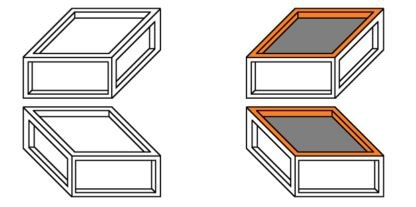Colour in the context of design registration protection in the UK, and when it can be worth considering
In the context of protecting the appearance of a consumer product in the UK using design registration protection, a focus on protecting the shape of the product is usually a promising starting point. Though, particularly when it comes to lookalikes, anyone seeking to mimic the appearance of a consumer product will typically look to mimic all aspects of its appearance, not just its shape. Colour falls high up on the list of potential areas for imitation.
To the extent a consumer product is going to have some particular colour scheme, at least as far as the UK is concerned, it is worth considering whether any design registration protection might cover not just the shape of the product alone (for example, by showing the product in a black and white drawing format), but also variants where elements of colour are additionally included as part of the design registration protection.
Where colour is employed in a UK design registration, this does not mean necessarily that all parts of the product should be shown in colour in the registration. Indeed, excessive usage of colour in a design registration can often make its resultant scope of protection narrow, and more straightforward for a competitor to design around. But more surgical use of colour in a UK design registration can often be invaluable, particularly in instances where the colour is focussed to areas which contribute to the overall consumer perception of the product, or its underlying brand.
This “hybrid” approach, of showing some parts of the product in a UK design registration with colour depicted, yet other parts with no colour depicted, allows a focussing of the design registration protection to where mimicry of the product is perceived to most likely occur. Such an approach, of course, requires a fair understanding of any relevant underlying branding for the product, along with associated consumer (or competitor) behaviours relating the product, to pinpoint which aspects of the colour from the product might be important, and hence worth protecting.
To the extent colour is employed in a UK design registration, considerable care must be taken in ensuring that the extent of protection for the resultant design registration is clear. Specifically, usage of such hybrid UK design registrations, (which depict some parts of the registration in black and white line drawings, yet other parts with colour included as part of the protection) typically favour appropriate written disclaimer wording added to the registration to make this fact clear – for instance, to avoid the “white” parts of the registration being construed as covering something which is expressly white.
Relationship with unregistered UK design rights
Concerning the design rights regime in the UK more generally, also noteworthy is that the longer of the two forms of unregistered design right protection in the UK does not protect surface decoration, and consequently any colour(s) employed in a product. So unless any colour is included in a UK design registration(s), as far as UK design rights are concerned, any colour aspects in a product sold in the UK will usually only be protected, at best, for three years from the date when the design of the product is first publicly disclosed. Of course, other forms of intellectual property may be available for enforcing colour aspects from a given consumer product, such as copyright, the tort of passing off, or potentially even a trade mark. Though focussing on design rights specifically, the above-noted three years’ worth of design right protection may not be applicable to all products sold in the UK, but rather only those whose underlying design is first publicly disclosed in the UK. So, if a design of product was first publicly disclosed outside of the UK, such as in the EU or the USA for example, unless any UK design registration protection is obtained where colour is included as part of its protection, there would be no design rights in the UK which would protect any colour schemes employed in the product.
It is also worth noting that usage of colour in a UK design registration should invariably be considered as a supplement, not an alternative, to any UK design registration which protects the shape of a product alone. This is assuming that the shape of the product is itself suitably new, and hence validly protectable in its own right. This is so not least because not all design registries around the world permit the usage of colour in a design registration as liberally as the UK design registry does. So, solely employing a UK design registration which includes colour may make this protection more difficult to reproduce outside the UK before other design registries around the world. The other reason is cost: noting the official fees for obtaining a single UK design registration start at £50, whereas the official fees for pursuing up to ten UK design registrations in a single application can be as little as £70. Assuming the underlying shape of a product which is proposed for design registration protection is itself new, any UK design registration protection might include at least one design registration without any colour employed. The option for additional design registrations can then be pursued in the same application which employ surgical usage of colour, where such colour is perceived as being prone to imitation.
Impact of colour in the context of more “global” design registration portfolios
This has further significance to those entities based outside of the UK who might be contemplating design registration protection in their “home” territory first, and then seeking commensurate protection before the UK design registry later on (within the six month priority period for doing so). In these situations, thought might be given as to whether any first-submitted registered design application in this home territory (for example, in the USA) might contain additional design variants for subsequent use before the UK design registry, where colour is additionally included in the scope of the protection.
This approach may be beneficial, even if these additional design variants including any colour are immediately removed from the first-submitted registered design application in the home territory, straight after this application has been submitted. This might happen because of cost considerations. For example, in situations where the design registry of the home territory might not permit a single application to ultimately protect multiple design variants, or because the presence of colour is not ultimately allowed in design registrations issued by the home territory, in comparison to the UK design registry where such presence of colour is allowed.
Including such additional design variants in the first-submitted registered design application in the home territory may initially seem illogical, particularly if such colour variants are then immediately removed from this application straight after it has been submitted. However, the reason for considering this approach is that if the colour is not included as part of the materials from the first-submitted registered design application in the home territory any later-submitted UK registered design application which contains design variants where such colour is introduced for the first time will then not be entitled to claim the priority date of the first-submitted registered design application, because the colour was never present in that earlier application.
Contextual example
This is illustrated best with reference to an example. So, consider a situation of a furniture manufacturer devising a new table design, as illustrated below (assume this shape of table is new), where the table is generally cuboidal, with recessed portions added to each face of the cuboid. Also imagine the situation where the manufacturer is consistently known for producing furniture where the top portion of the furniture employs a characteristic combination of orange and black across all of its furniture designs.
In such an example, it might well be that any design registration protection in the UK might then want to contain two design registrations. That is, one with no colour added, such to protect the basic shape of the table on its own (for example, per the images below left), and another which protects this same shape of the table in combination with the characteristic orange and black colouring for just the top portion of the furniture (for example, per the images below right). To the extent that design registration protection may be initially pursed outside of the UK, it would be desirable to ensure that this second design variant, which includes the orange and black colouring, is contained in any first-submitted registered design application in the initial territory outside the UK, even if this second design variant is immediately removed from this application in the initial territory straight after the application is first submitted.

Summary
The usage of colour in a UK design registration portfolio can have its benefits, though it is not a panacea applicable to all situations. To the extent colour is of interest for inclusion in a UK design registration, careful thought must be given to how this protection is sought in practice before the UK design registry.
Though, in the right circumstances, colour certainly has its place in any UK design registration portfolio.
